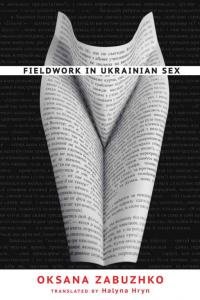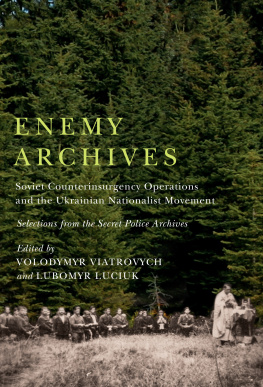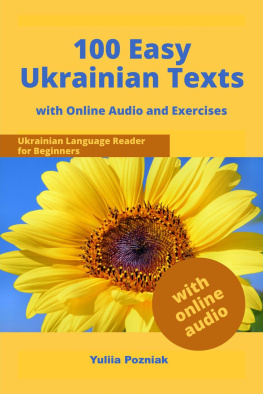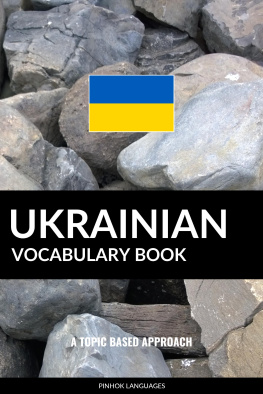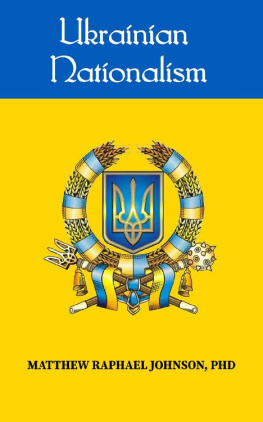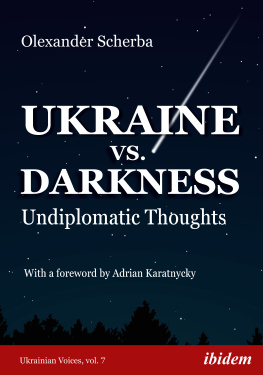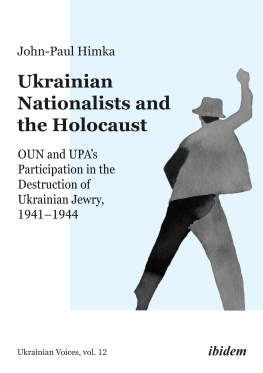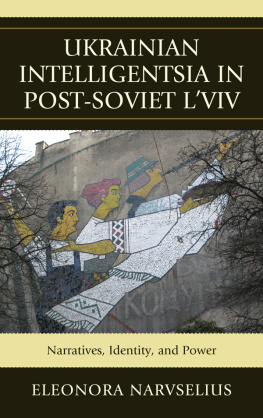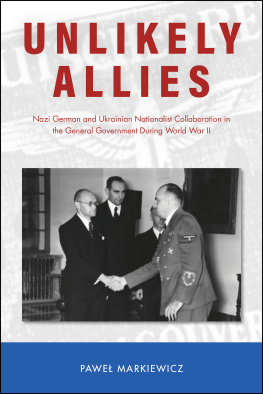P reface and Acknowledgments
My interest in Stepan Bandera was awakened about a decade ago when I came across a picture of the Bandera monument in the eastern Galician town of Dubliany and read an article that described the unveiling ceremony. The solemn mood of the crowd in the picture and the highly respectful attitude of the article toward Bandera and his movement puzzled me. After this encounter I examined a number of academic and non-academic writings relating to Bandera, his role in Ukrainian and European his tory, and in the collective memory of Ukrainians, Jews, Poles, Russians, and other peoples. These publications, however, did not satisfy my curiosity. The characteri - zations of Bandera and his movement were intriguing but they lacked substance and many were superficial. Because of the lack of reliable information about the subject, it took me several years to define the bases and to comprehend its essentials. The more time I spent in the archives and libraries, the more I was astonished how mythical and escapist the Bandera images are. Interviewing various activists and investigating Bandera museums, I realized how much Bandera meant to people who had made him a part of their identity and how little they were interested in a more realistic understanding of the man and his movement. I also noticed a concealed hostility toward critical examination of the subject and deduced that the common representations of Bandera, whether apologetic or demonizing, were based on dis avowal of certain aspects of his past and on collective misinformation, in particular in post-Soviet western Ukraine.
Investigating the early post-war period, I realized that our understanding of Ban dera and his movement had been based to a substantial extent on that movement s propaganda, which had been modified after the Second World War and adjusted to the realities of the Cold War by the veterans of the movement and its sympathizers. Several thousand of these people had left western Ukraine together with the Ger mans during the last phase of the war and remained thereafter in various countries of the Western bloc. Their narrative of the events in western Ukraine during the Second World War was not challenged by professional historians until recently. On the con trary , some of the historians who studied Ukrainian nationalism during the Cold War adopted parts of this distorted and selective narrative in their own writings , taking the memories and self-representations of the veterans of the movement for granted . After the dissolution of the Soviet Union, a number of political activists and scholars based in western Ukraine presented explanations of the subject that were again very similar to those popularized previously by the movement s veterans and by some historians rooted in the Ukrainian diaspora. In other words the subject has remained unexplored for a long period of time , and i ts investigation has bec o me difficult and even dangerous .
The theoretical part of my work, in particular the contextualization of Bandera and his movement among other East Central European fascist movements, evoked fierce reactions among far-right activists, and it irritated several historians and intellectuals , including experts in the fields of Polish, Soviet, and Ukrainian history . Equally intense emotions were aroused when I began to connect the apologetic commemorations and representations of Bandera and his followers with the involvement of Ukrainian nationalists and ordinary Ukrainians in the Holocaust and other forms of mass violence during and after the Second World War. To my sur prise, some historians who had not worked in the field of Ukrainian history, but had specialized in subjects such as mass violence, fascism, nationalism, the Holocaust or its denial, had far fewer problems accepting the results of my research and following the narrative of this study.
When I was planning to investigate Bandera and his movement in depth and to write a comprehensive study about them, several scholars warned me that it would be better to choose a less contentious topic for a dissertation. As it turned out, the reactions to my research and to some of my findings exceeded their direst predic tions. Especially in the last phase of writing this book, I was exposed to a number of unpleasant attacks on this study and sometimes also on my person. These attacks came both from the Ukrainian far right and from scholars who regarded Bandera as a national or local hero, and his followers as an anti-German and anti-Soviet resistance movement, or as the Ukrainian liberation movement. Many people directly or indi rectly expressed the opinion that the investigation of subjects such as the mass violence conducted by the Ukrainian nationalists, the Bandera cult, and the Holo caust denial among the Ukrainian diaspora and post-Soviet intellectuals constitutes an attack on Ukrainian identity, and they questioned the usefulness and integrity of such research.
When the Heinrich Bll Foundation, the German Academic Exchange Service, and the German embassy in Kiev invited me to deliver six lectures about Bandera in three Ukrainian cities in late February and early March 2012, organized hysteria was stirred up, not only among Ukrainian far-right activists and nationalist scholars but also among a number of liberal scholars in Ukraine and some scholars of East European history in other countries. The organizers of the lecture tour had great difficulty in finding universities or other institutions with sufficient courage to host my lectures. Venues were found in Kiev and Dnipropetrovs k, but none in Lviv. In the event, even the four institutions (including the Tkuma Ukrainian Institute for Holo caust Studies) that had agreed to my appearance canceled the lectures a few hours prior to their planned start. As a result, only one lecture took place, in secure con ditions in the premises of the German embassy in Kiev. In front of the building, about a hundred angry protesters tried to convince a few hundred interested stu dents, scholars, and ordinary Ukrainians not to attend my lecture , claiming that I was Josef Goebbels grandchild and a liberal fascist from Berlin, who did not understand anything about the subject he would talk about.
The lectures in Ukraine in early 2012 were prevented by two kinds of political and intellectual opponents. The first group consisted of far-right activists from the Svo boda Party who intimidated the universities and other institutions. The second group was composed of nationalist and liberal intellectuals and scholars, who contacted the institutions and also announced in public that it would be better not to allow me to speak on the subject of my research, because I was not a historian but a propa gandist who would besmirch the country or attempt to spark a civil war and split Ukraine. During the wave of disturbing and hostile insults and protests, a number of people, including Antony Polonsky, Delphine Bechtel, Per Anders Rudling, Marco Carynnyk, Andreas Umland, Jared McBride, Mark von Hagen, Arnd Bauerkmper, Christian Ganzer, Frank Golczewski, Anton Shekhovtsov, Gertrud Pickhan, Grzegorz Motyka, Omer Bartov, Simon Hadler, Susanne Heim, and especially my wife Mar tina, were very supportive. These people convinced me not to pay too much attention to the various kinds of nationalist and intellectual hysteria and to concentrate on finishing the study and publishing the book.
This study could not have been accomplished without the help and support of many people and institutions. At the very beginning of this undertaking, Philipp Ther convinced me to see it through. Heinz Dieter Kittsteiner ( 2008), an inspiring theo retician and a remarkable critic of collective memories, did so too. During the entire project, my dissertation adviser Frank Golczewski supported me with advice on vari ous academic matters and helped me to face sundry bureaucratic obstacles. In Ukraine, Leonid Zashkilniak, Iaroslav Hrytsak, Ostap Sereda, and a number of other colleagues helped me to locate and extract some essential documents and to over come many kinds of administrative complications. Similarly, several archivists and librarians in Canada, Germany, Poland, Russia, Ukraine, the United Kingdom, and the United States were very helpful during my investigations. John-Paul Himka taught me a great deal about the Ukrainian diaspora and its nationalist misrepresentation of history. He and scholars such as Omer Bartov, Dieter Pohl, Grzegorz Motyka, and Per Anders Rudling drew my attention to the question of ethnic and political violence and its significance for this study. The writings on fascism by scholars such as Arnd Bauerkmper, Roger Eatwell, Roger Griffin, Constantin Iordachi, Michael Mann, Stanley G. Payne, Kevin Passmore, Robert Paxton, and Zeev Sternhell helped me to contextualize Bandera and his movement.


